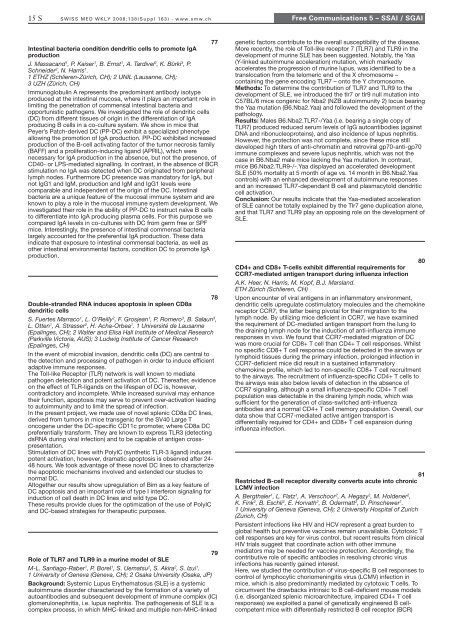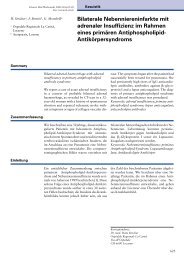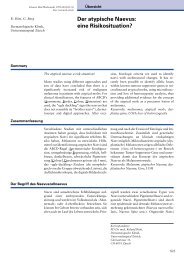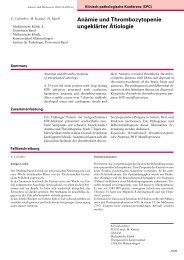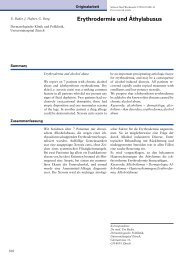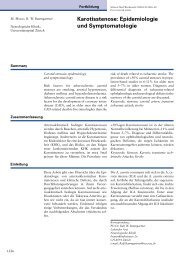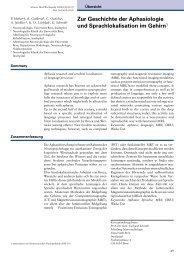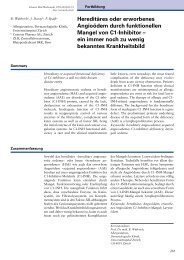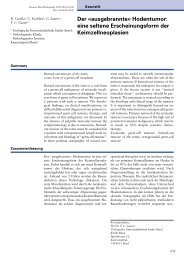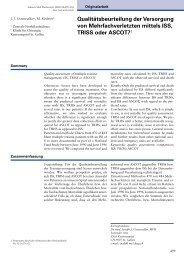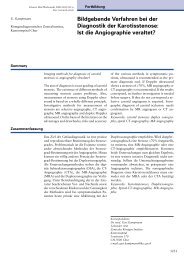Supplementum 163 - Swiss Medical Weekly
Supplementum 163 - Swiss Medical Weekly
Supplementum 163 - Swiss Medical Weekly
Create successful ePaper yourself
Turn your PDF publications into a flip-book with our unique Google optimized e-Paper software.
15 S SWISS MED WKLY 2008;138(Suppl <strong>163</strong>) · www.smw.ch<br />
Free Communications 5 – SSAI / SGAI<br />
77<br />
Intestinal bacteria condition dendritic cells to promote IgA<br />
production<br />
J. Massacand1 , P. Kaiser1 , B. Ernst1 , A. Tardivel2 , K. Bürki3 , P.<br />
Schneider2 , N. Harris1 .<br />
1 ETHZ (Schlieren-Zürich, CH); 2 UNIL (Lausanne, CH);<br />
3 UZH (Zürich, CH)<br />
Immunoglobulin A represents the predominant antibody isotype<br />
produced at the intestinal mucosa, where it plays an important role in<br />
limiting the penetration of commensal intestinal bacteria and<br />
opportunistic pathogens. We investigated the role of dendritic cells<br />
(DC) from different tissues of origin in the differentiation of IgA<br />
producing B cells in a co-culture system. We show in mice that<br />
Peyer’s Patch-derived DC (PP-DC) exhibit a specialized phenotype<br />
allowing the promotion of IgA production. PP-DC exhibited increased<br />
production of the B-cell activating factor of the tumor necrosis family<br />
(BAFF) and a proliferation-inducing ligand (APRIL), which were<br />
necessary for IgA production in the absence, but not the presence, of<br />
CD40- or LPS-mediated signalling. In contrast, in the absence of BCR<br />
stimulation no IgA was detected when DC originated from peripheral<br />
lymph nodes. Furthermore DC presence was mandatory for IgA, but<br />
not IgG1 and IgM, production and IgM and IgG1 levels were<br />
comparable and independent of the origin of the DC. Intestinal<br />
bacteria are a unique feature of the mucosal immune system and are<br />
known to play a role in the mucosal immune system development. We<br />
investigated their role in the ability of PP-DC to instruct naïve B cells<br />
to differentiate into IgA producing plasma cells. For this purpose we<br />
compared IgA levels in co-cultures with DC from germ free or SPF<br />
mice. Interestingly, the presence of intestinal commensal bacteria<br />
largely accounted for the preferential IgA production. These data<br />
indicate that exposure to intestinal commensal bacteria, as well as<br />
other intestinal environmental factors, condition DC to promote IgA<br />
production.<br />
78<br />
Double-stranded RNA induces apoptosis in spleen CD8a<br />
dendritic cells<br />
S. Fuertes Marraco1 , L. O’Reilly2 , F. Grosjean1 , P. Romero3 , B. Salaun3 ,<br />
L. Otten1 , A. Strasser2 , H. Acha-Orbea1 . 1 Université de Lausanne<br />
(Epalinges, CH); 2 Walter and Elisa Hall Institute of <strong>Medical</strong> Research<br />
(Parkville Victoria, AUS); 3 Ludwig Institute of Cancer Research<br />
(Epalinges, CH)<br />
In the event of microbial invasion, dendritic cells (DC) are central to<br />
the detection and processing of pathogen in order to induce efficient<br />
adaptive immune responses.<br />
The Toll-like Receptor (TLR) network is well known to mediate<br />
pathogen detection and potent activation of DC. Thereafter, evidence<br />
on the effect of TLR-ligands on the lifespan of DC is, however,<br />
contradictory and incomplete. While increased survival may enhance<br />
their function, apoptosis may serve to prevent over-activation leading<br />
to autoimmunity and to limit the spread of infection.<br />
In the present project, we made use of novel splenic CD8a DC lines,<br />
derived from tumors in mice transgenic for the SV40 Large T<br />
oncogene under the DC-specific CD11c promoter, where CD8a DC<br />
preferentially transform. They are known to express TLR3 (detecting<br />
dsRNA during viral infection) and to be capable of antigen crosspresentation.<br />
Stimulation of DC lines with PolyIC (synthetic TLR-3 ligand) induces<br />
potent activation, however, dramatic apoptosis is observed after 24-<br />
48 hours. We took advantage of these novel DC lines to characterize<br />
the apoptotic mechanisms involved and extended our studies to<br />
normal DC.<br />
Altogether our results show upregulation of Bim as a key feature of<br />
DC apoptosis and an important role of type I interferon signaling for<br />
induction of cell death in DC lines and wild type DC.<br />
These results provide clues for the optimization of the use of PolyIC<br />
and DC-based strategies for therapeutic purposes.<br />
79<br />
Role of TLR7 and TLR9 in a murine model of SLE<br />
M-L. Santiago-Raber1 , P. Borel1 , S. Uematsu2 , S. Akira2 , S. Izui1 .<br />
1 University of Geneva (Geneva, CH); 2 Osaka University (Osaka, JP)<br />
Background: Systemic Lupus Erythematosus (SLE) is a systemic<br />
autoimmune disorder characterized by the formation of a variety of<br />
autoantibodies and subsequent development of immune complex (IC)<br />
glomerulonephritis, i.e. lupus nephritis. The pathogenesis of SLE is a<br />
complex process, in which MHC-linked and multiple non-MHC-linked<br />
genetic factors contribute to the overall susceptibility of the disease.<br />
More recently, the role of Toll-like receptor 7 (TLR7) and TLR9 in the<br />
development of murine SLE has been suggested. Notably, the Yaa<br />
(Y-linked autoimmune acceleration) mutation, which markedly<br />
accelerates the progression of murine lupus, was identified to be a<br />
translocation from the telomeric end of the X chromosome –<br />
containing the gene encoding TLR7 – onto the Y chromosome.<br />
Methods: To determine the contribution of TLR7 and TLR9 to the<br />
development of SLE, we introduced the tlr7 or tlr9 null mutation into<br />
C57BL/6 mice congenic for Nba2 (NZB autoimmunity 2) locus bearing<br />
the Yaa mutation (B6.Nba2.Yaa) and followed the development of the<br />
pathology.<br />
Results: Males B6.Nba2.TLR7-/Yaa (i.e. bearing a single copy of<br />
TLR7) produced reduced serum levels of IgG autoantibodies (against<br />
DNA and ribonucleoproteins), and also incidence of lupus nephritis.<br />
However, the protection was not complete, since these mice still<br />
developed high titers of anti-chromatin and retroviral gp70-anti-gp70<br />
immune complexes and severe lupus nephritis, which was not the<br />
case in B6.Nba2 male mice lacking the Yaa mutation. In contrast,<br />
mice B6.Nba2.TLR9-/-.Yaa displayed an accelerated development<br />
SLE (50% mortality at 5 month of age vs. 14 month in B6.Nba2.Yaa<br />
controls) with an enhanced development of autoimmune responses<br />
and an increased TLR7-dependant B cell and plasmacytoïd dendritic<br />
cell activation.<br />
Conclusion: Our results indicate that the Yaa-mediated acceleration<br />
of SLE cannot be totally explained by the Tlr7 gene duplication alone,<br />
and that TLR7 and TLR9 play an opposing role on the development of<br />
SLE.<br />
80<br />
CD4+ and CD8+ T-cells exhibit differential requirements for<br />
CCR7-mediated antigen transport during influenza infection<br />
A.K. Heer, N. Harris, M. Kopf, B.J. Marsland.<br />
ETH Zürich (Schlieren, CH)<br />
Upon encounter of viral antigens in an inflammatory environment,<br />
dendritic cells upregulate costimulatory molecules and the chemokine<br />
receptor CCR7, the latter being pivotal for their migration to the<br />
lymph node. By utilizing mice deficient in CCR7, we have examined<br />
the requirement of DC-mediated antigen transport from the lung to<br />
the draining lymph node for the induction of anti-influenza immune<br />
responses in vivo. We found that CCR7-mediated migration of DC<br />
was more crucial for CD8+ T cell than CD4+ T cell responses. Whilst<br />
no specific CD8+ T cell response could be detected in the airways or<br />
lymphoid tissues during the primary infection, prolonged infection in<br />
CCR7-deficient mice did result in a sustained inflammatory<br />
chemokine profile, which led to non-specific CD8+ T cell recruitment<br />
to the airways. The recruitment of influenza-specific CD4+ T cells to<br />
the airways was also below levels of detection in the absence of<br />
CCR7 signaling, although a small influenza-specific CD4+ T cell<br />
population was detectable in the draining lymph node, which was<br />
sufficient for the generation of class-switched anti-influenza<br />
antibodies and a normal CD4+ T cell memory population. Overall, our<br />
data show that CCR7-mediated active antigen transport is<br />
differentially required for CD4+ and CD8+ T cell expansion during<br />
influenza infection.<br />
81<br />
Restricted B-cell receptor diversity converts acute into chronic<br />
LCMV infection<br />
A. Bergthaler 1 , L. Flatz 1 , A. Verschoor 2 , A. Hegazy 2 , M. Holdener 2 ,<br />
K. Fink 2 , B. Eschli 2 , E. Horvath 2 , B. Odermatt 2 , D. Pinschewer 1 .<br />
1 University of Geneva (Geneva, CH); 2 University Hospital of Zurich<br />
(Zurich, CH)<br />
Persistent infections like HIV and HCV represent a great burden to<br />
global health but preventive vaccines remain unavailable. Cytotoxic T<br />
cell responses are key for virus control, but recent results from clinical<br />
HIV trials suggest that coordinate action with other immune<br />
mediators may be needed for vaccine protection. Accordingly, the<br />
contributive role of specific antibodies in resolving chronic virus<br />
infections has recently gained interest.<br />
Here, we studied the contribution of virus-specific B cell responses to<br />
control of lymphocytic choriomeningitis virus (LCMV) infection in<br />
mice, which is also predominantly mediated by cytotoxic T cells. To<br />
circumvent the drawbacks intrinsic to B cell-deficient mouse models<br />
(i.e. disorganized splenic microarchitecture, impaired CD4+ T cell<br />
responses) we exploited a panel of genetically engineered B cellcompetent<br />
mice with differentially restricted B cell receptor (BCR)


